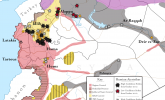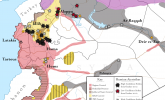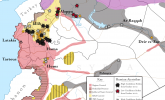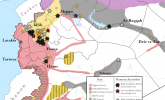Russian Airstrikes in Syria: September 30 - October 12
October 13, 2015 - Genevieve Casagrande


The Russian Ministry of Defense (MoD) continued to ramp up its aerial campaign in Syria, claiming to conduct 250 “combat sorties” from October 9-12. This spike in Russian military activity is a notable escalation compared to the 20 “combat sorties” flown on October 8.



Russia's Syrian campaign is part of larger confrontation with the U.S. and NATO. In addition to expanding the scope of its operations to bolster the regime of Bashar al-Assad, Russia issued an open challenge to NATO through repeated violations of Turkish airspace, the shadowing of U.S. Predator drones in Syria, and the launch of cruise missiles into Syria from the Caspian Sea through Iraqi airspace without warning the U.S. beforehand. Russia accelerated its efforts to court U.S.


Russia's Syrian campaign is part of larger confrontation with the U.S. and NATO. In addition to expanding the scope of its operations to bolster the regime of Bashar al-Assad, Russia issued an open challenge to NATO through repeated violations of Turkish airspace, the shadowing of U.S. Predator drones in Syria, and the launch of cruise missiles into Syria from the Caspian Sea through Iraqi airspace without warning the U.S. beforehand.

The Russian formation of a coordination cell in Baghdad is an inflection point aimed at undercutting U.S. influence over the direction of the anti-ISIS efforts in Iraq and Syria. However, the Russian footprint in Iraq is much smaller than in Syria, while U.S. influence over the ISF and Iraqi state are much greater than U.S. influence in Syria. The U.S. and the U.S.-led Coalition can maintain its position as Iraq’s essential ally in the anti-ISIS fight by increasing advisory, materiel, and aerial support to the Iraqi state, without substantially increasing its ground presence.